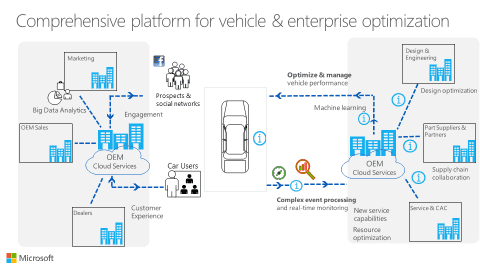The Big Shift: Transforming the automotive value chain in a connected world
© Keith Lewis | Dreamstime Stock Photos
With an always-on connection, consumer expectations have drastically changed when it comes to their vehicle—from their shopping and ownership experiences to the very essence of the automobile as it becomes an extension to their digitally-connected lifestyle.
In this post, I’ll share our thinking on how this is also having deep implications on the automotive value chain. Besides keeping pace with market changes, the capabilities to transform the OEM business are readily available today. So, how to get started?
A holistic view for transformation
As automakers define their strategies in this world of pervasive connectivity, we strongly believe that to succeed organizations need to focus on both the customer experience and also on their value network. The two are increasingly interconnected, and managing a high-performance connected business network that integrates the vehicle lifecycle into the global value chain is critical to delivering the next generation of connected consumer experiences.
We believe it’s best to start with a holistic view that incorporates:
• both the in-vehicle and off board user experience
• vehicle performance optimization enabled by reasoning on telemetry data captured over its lifecycle
• integration of driver and vehicle data insights into core enterprise business processes such as engineering and supply chain
• multi-channel engagement in marketing
• personalized sales and dealer experiences
This chart shows a comprehensive platform for vehicle and enterprise optimization pivoted on data that enables insights across the full range of business processes from vehicle operation and back into the enterprise. Aided by a wealth of technologies such as smart connected vehicles, cloud, and big data, the platform enables capabilities for manufacturers to innovate and transform the way they design, sell, and service vehicles, while remaining in direct connection with their customers – for the first time ever.
Real results
As cloud computing and data management technologies have matured over the last few years, these technologies present the biggest enablers to transform business processes and customer experiences and offer automakers more opportunities for innovation and differentiation. Read more about the $371 billion opportunity for “data smart” manufacturers.
Here are just a few examples where these capabilities can be utilized for big gains.
• Vehicle Performance. Analytics applied to streaming data from vehicle telemetry (also known as complex event processing) can enable early warning signals such as brake-wear or battery charge problems, alerting customer assistance before an actual problem occurs. Cloud-based tools like Machine Learning can be applied to aggregate vehicle data to develop optimal performance settings and even adjust performance for optimal safety or fuel conservation based on actual driving conditions.
• Design & Engineering. Data analysis from operational vehicles can yield insights about the actual performance of key components in the vehicles and compared with as-designed simulations. This can lead to better designs for reliability and performance while reducing costs on over-designed components.
• Supply Chain Collaboration. Data can also be shared securely and easily with supply-chain partners to improve component design, cost, or performance. Analytics and actual vehicle condition can be accessed by service centers for better and improved service. Integration of vehicle codes with electronic technical manuals can make it faster and easier for service reps and technicians to provide improved responses.
• Sales & Marketing. Analytics can also yield valuable consumer/driver insights for marketing teams to develop campaign themes, localization, and engagements through social networks and other digital channels. Monitoring of digital challenges enables real-time understanding of brand sentiment and competition. Dealerships also are better able to engage earlier in the buying cycle and make the dealer experience a pleasant and satisfying one.
Our Microsoft capabilities for the connected vehicle are unique in their ability to deliver a comprehensive platform that spans both the consumer (driver, owner, car users) and the enterprise so automakers can quickly develop scenarios prioritized to dynamic market and enterprise needs, while resting assured that their foundation and investments will continue to enable differentiated value over the long run. We also offer the most choice and flexibility for manufacturers to help accelerate cloud adoption and take advantage of its business value. In this increasingly connected world, this becomes even more critical for players in the automotive industry as the boundaries with other industries are starting to blur and the vehicle is being absorbed by the connected ecosystem. (I’ll talk more about this in an upcoming blog post.)
For any questions, please contact msmfg@microsoft.com.






